Social Determinants of Health
VerifiedAdded on 2023/01/17
|7
|1932
|92
AI Summary
This report analyzes the case of a teenager suffering from alcohol consumption, inactivity, and low mood, and recommends ways to improve approaches for better support and recovery. The focus is on the social determinants of health and the importance of social support for adolescents.
Contribute Materials
Your contribution can guide someone’s learning journey. Share your
documents today.
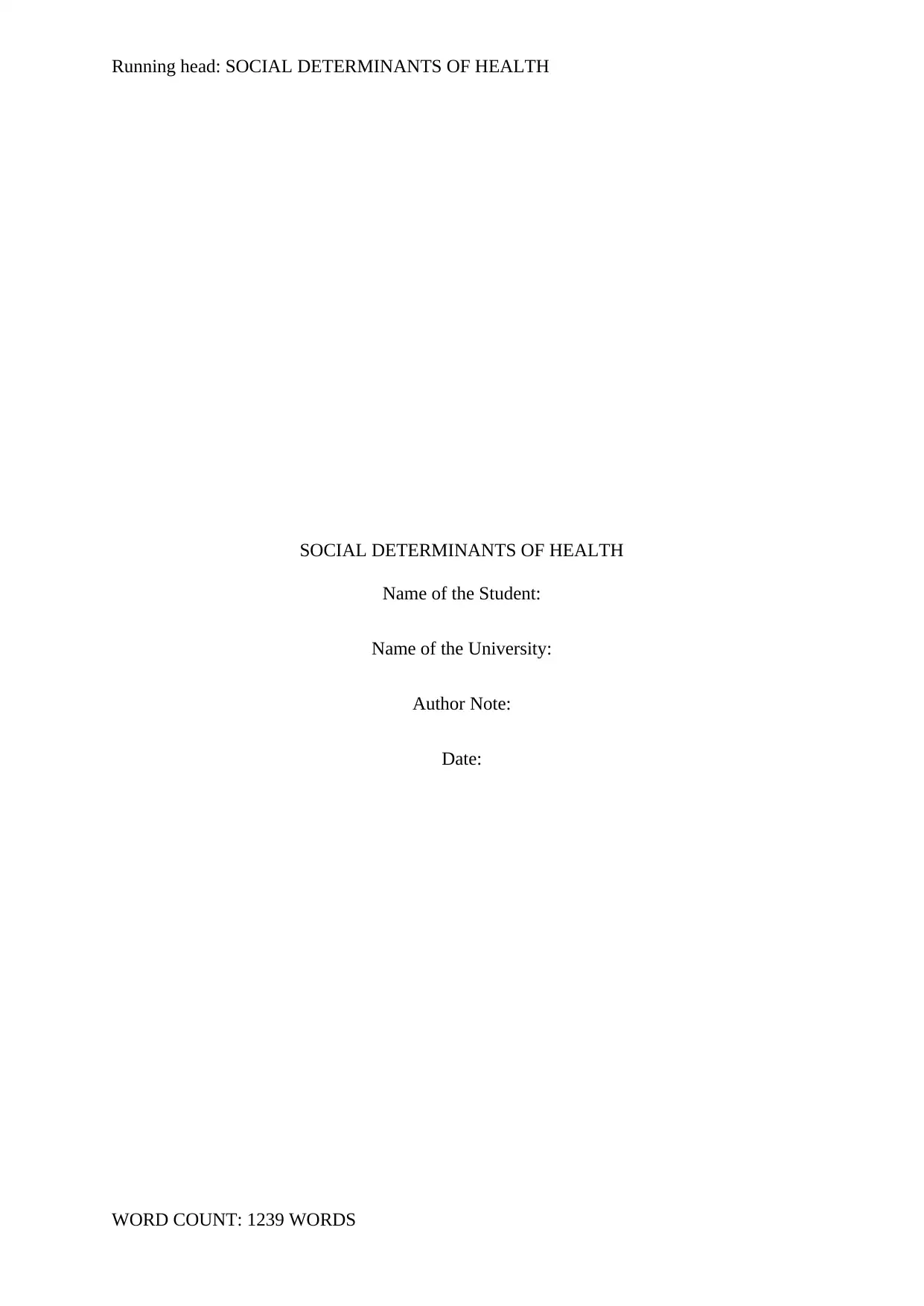
Running head: SOCIAL DETERMINANTS OF HEALTH
SOCIAL DETERMINANTS OF HEALTH
Name of the Student:
Name of the University:
Author Note:
Date:
WORD COUNT: 1239 WORDS
SOCIAL DETERMINANTS OF HEALTH
Name of the Student:
Name of the University:
Author Note:
Date:
WORD COUNT: 1239 WORDS
Secure Best Marks with AI Grader
Need help grading? Try our AI Grader for instant feedback on your assignments.
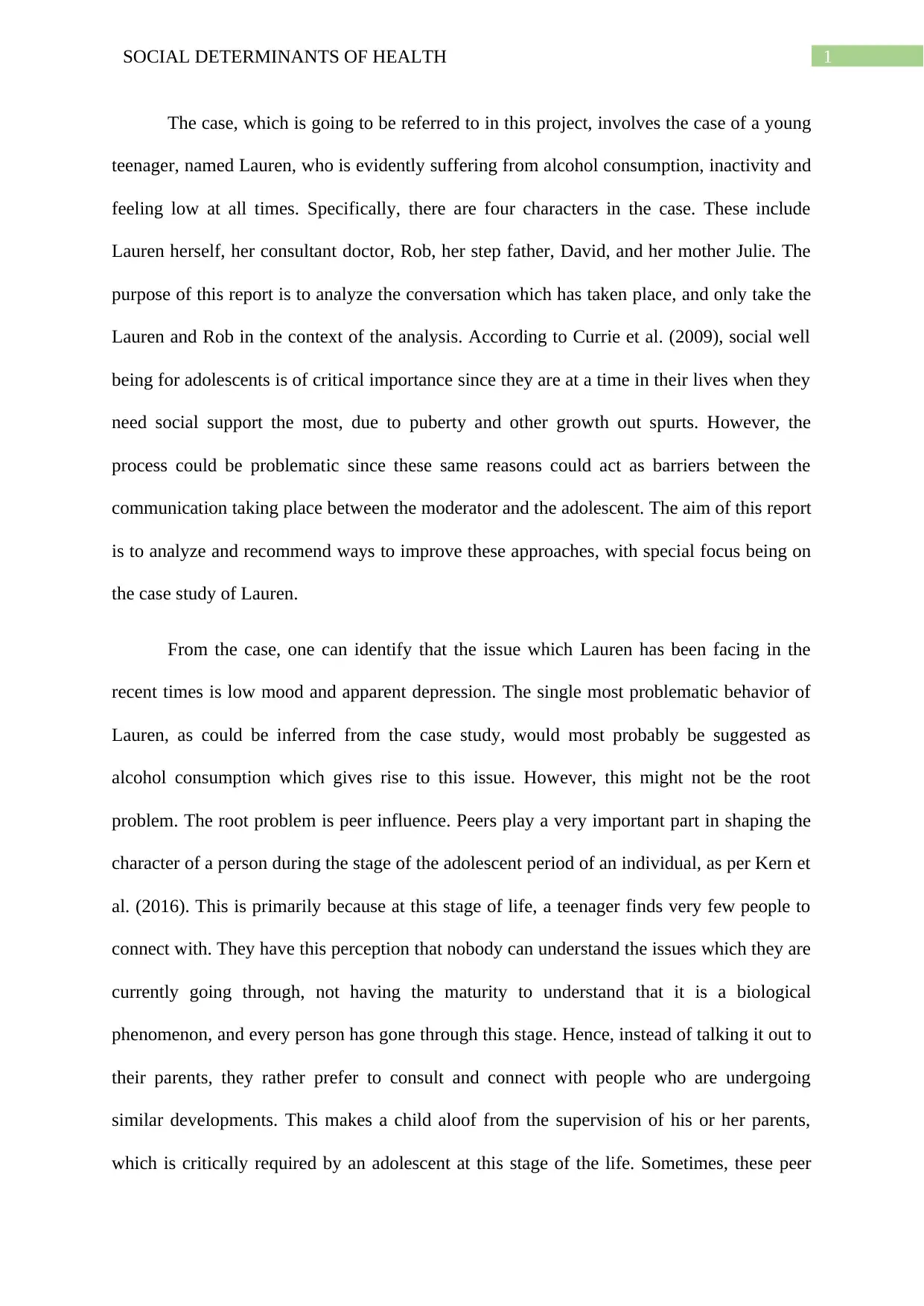
1SOCIAL DETERMINANTS OF HEALTH
The case, which is going to be referred to in this project, involves the case of a young
teenager, named Lauren, who is evidently suffering from alcohol consumption, inactivity and
feeling low at all times. Specifically, there are four characters in the case. These include
Lauren herself, her consultant doctor, Rob, her step father, David, and her mother Julie. The
purpose of this report is to analyze the conversation which has taken place, and only take the
Lauren and Rob in the context of the analysis. According to Currie et al. (2009), social well
being for adolescents is of critical importance since they are at a time in their lives when they
need social support the most, due to puberty and other growth out spurts. However, the
process could be problematic since these same reasons could act as barriers between the
communication taking place between the moderator and the adolescent. The aim of this report
is to analyze and recommend ways to improve these approaches, with special focus being on
the case study of Lauren.
From the case, one can identify that the issue which Lauren has been facing in the
recent times is low mood and apparent depression. The single most problematic behavior of
Lauren, as could be inferred from the case study, would most probably be suggested as
alcohol consumption which gives rise to this issue. However, this might not be the root
problem. The root problem is peer influence. Peers play a very important part in shaping the
character of a person during the stage of the adolescent period of an individual, as per Kern et
al. (2016). This is primarily because at this stage of life, a teenager finds very few people to
connect with. They have this perception that nobody can understand the issues which they are
currently going through, not having the maturity to understand that it is a biological
phenomenon, and every person has gone through this stage. Hence, instead of talking it out to
their parents, they rather prefer to consult and connect with people who are undergoing
similar developments. This makes a child aloof from the supervision of his or her parents,
which is critically required by an adolescent at this stage of the life. Sometimes, these peer
The case, which is going to be referred to in this project, involves the case of a young
teenager, named Lauren, who is evidently suffering from alcohol consumption, inactivity and
feeling low at all times. Specifically, there are four characters in the case. These include
Lauren herself, her consultant doctor, Rob, her step father, David, and her mother Julie. The
purpose of this report is to analyze the conversation which has taken place, and only take the
Lauren and Rob in the context of the analysis. According to Currie et al. (2009), social well
being for adolescents is of critical importance since they are at a time in their lives when they
need social support the most, due to puberty and other growth out spurts. However, the
process could be problematic since these same reasons could act as barriers between the
communication taking place between the moderator and the adolescent. The aim of this report
is to analyze and recommend ways to improve these approaches, with special focus being on
the case study of Lauren.
From the case, one can identify that the issue which Lauren has been facing in the
recent times is low mood and apparent depression. The single most problematic behavior of
Lauren, as could be inferred from the case study, would most probably be suggested as
alcohol consumption which gives rise to this issue. However, this might not be the root
problem. The root problem is peer influence. Peers play a very important part in shaping the
character of a person during the stage of the adolescent period of an individual, as per Kern et
al. (2016). This is primarily because at this stage of life, a teenager finds very few people to
connect with. They have this perception that nobody can understand the issues which they are
currently going through, not having the maturity to understand that it is a biological
phenomenon, and every person has gone through this stage. Hence, instead of talking it out to
their parents, they rather prefer to consult and connect with people who are undergoing
similar developments. This makes a child aloof from the supervision of his or her parents,
which is critically required by an adolescent at this stage of the life. Sometimes, these peer
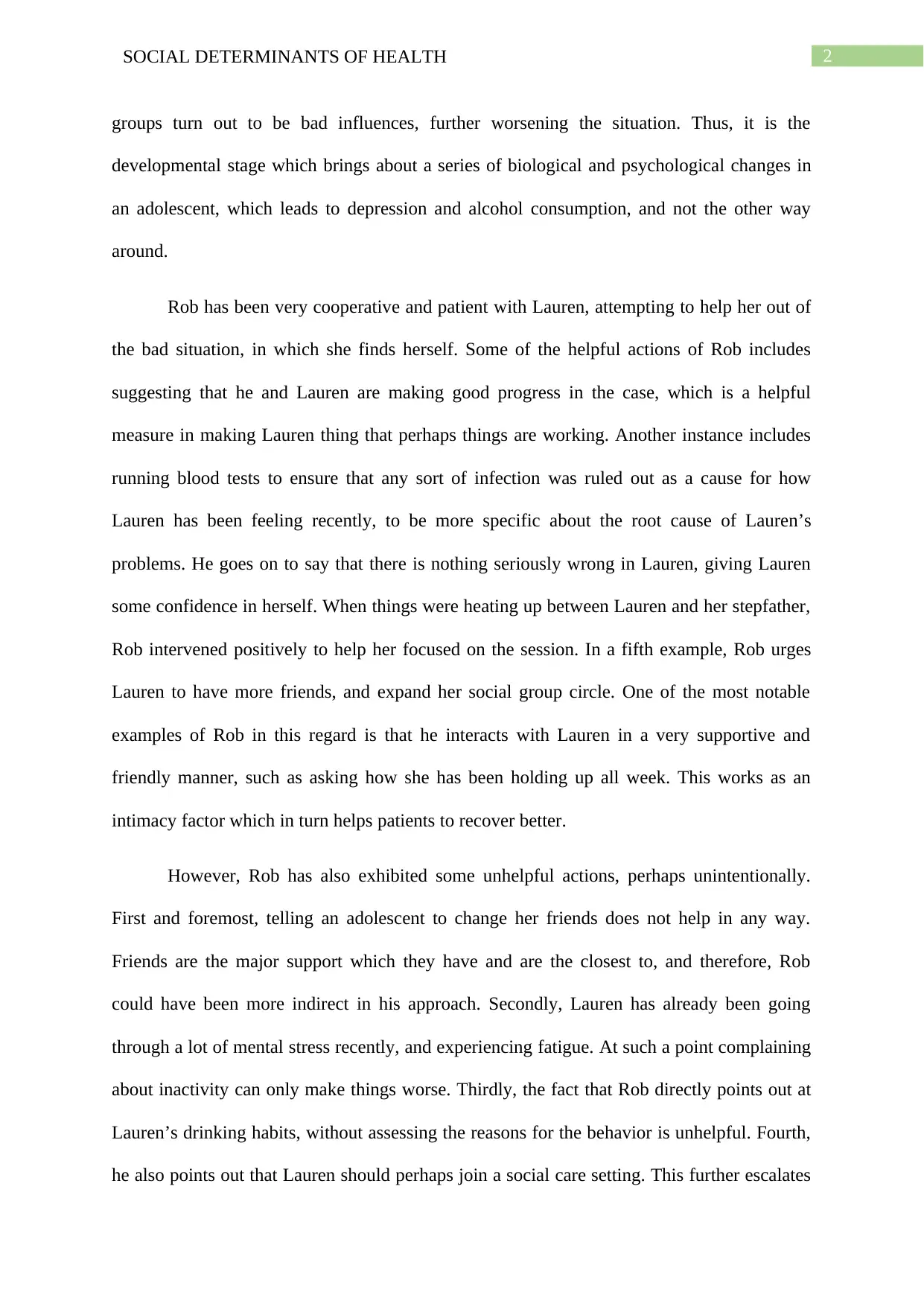
2SOCIAL DETERMINANTS OF HEALTH
groups turn out to be bad influences, further worsening the situation. Thus, it is the
developmental stage which brings about a series of biological and psychological changes in
an adolescent, which leads to depression and alcohol consumption, and not the other way
around.
Rob has been very cooperative and patient with Lauren, attempting to help her out of
the bad situation, in which she finds herself. Some of the helpful actions of Rob includes
suggesting that he and Lauren are making good progress in the case, which is a helpful
measure in making Lauren thing that perhaps things are working. Another instance includes
running blood tests to ensure that any sort of infection was ruled out as a cause for how
Lauren has been feeling recently, to be more specific about the root cause of Lauren’s
problems. He goes on to say that there is nothing seriously wrong in Lauren, giving Lauren
some confidence in herself. When things were heating up between Lauren and her stepfather,
Rob intervened positively to help her focused on the session. In a fifth example, Rob urges
Lauren to have more friends, and expand her social group circle. One of the most notable
examples of Rob in this regard is that he interacts with Lauren in a very supportive and
friendly manner, such as asking how she has been holding up all week. This works as an
intimacy factor which in turn helps patients to recover better.
However, Rob has also exhibited some unhelpful actions, perhaps unintentionally.
First and foremost, telling an adolescent to change her friends does not help in any way.
Friends are the major support which they have and are the closest to, and therefore, Rob
could have been more indirect in his approach. Secondly, Lauren has already been going
through a lot of mental stress recently, and experiencing fatigue. At such a point complaining
about inactivity can only make things worse. Thirdly, the fact that Rob directly points out at
Lauren’s drinking habits, without assessing the reasons for the behavior is unhelpful. Fourth,
he also points out that Lauren should perhaps join a social care setting. This further escalates
groups turn out to be bad influences, further worsening the situation. Thus, it is the
developmental stage which brings about a series of biological and psychological changes in
an adolescent, which leads to depression and alcohol consumption, and not the other way
around.
Rob has been very cooperative and patient with Lauren, attempting to help her out of
the bad situation, in which she finds herself. Some of the helpful actions of Rob includes
suggesting that he and Lauren are making good progress in the case, which is a helpful
measure in making Lauren thing that perhaps things are working. Another instance includes
running blood tests to ensure that any sort of infection was ruled out as a cause for how
Lauren has been feeling recently, to be more specific about the root cause of Lauren’s
problems. He goes on to say that there is nothing seriously wrong in Lauren, giving Lauren
some confidence in herself. When things were heating up between Lauren and her stepfather,
Rob intervened positively to help her focused on the session. In a fifth example, Rob urges
Lauren to have more friends, and expand her social group circle. One of the most notable
examples of Rob in this regard is that he interacts with Lauren in a very supportive and
friendly manner, such as asking how she has been holding up all week. This works as an
intimacy factor which in turn helps patients to recover better.
However, Rob has also exhibited some unhelpful actions, perhaps unintentionally.
First and foremost, telling an adolescent to change her friends does not help in any way.
Friends are the major support which they have and are the closest to, and therefore, Rob
could have been more indirect in his approach. Secondly, Lauren has already been going
through a lot of mental stress recently, and experiencing fatigue. At such a point complaining
about inactivity can only make things worse. Thirdly, the fact that Rob directly points out at
Lauren’s drinking habits, without assessing the reasons for the behavior is unhelpful. Fourth,
he also points out that Lauren should perhaps join a social care setting. This further escalates
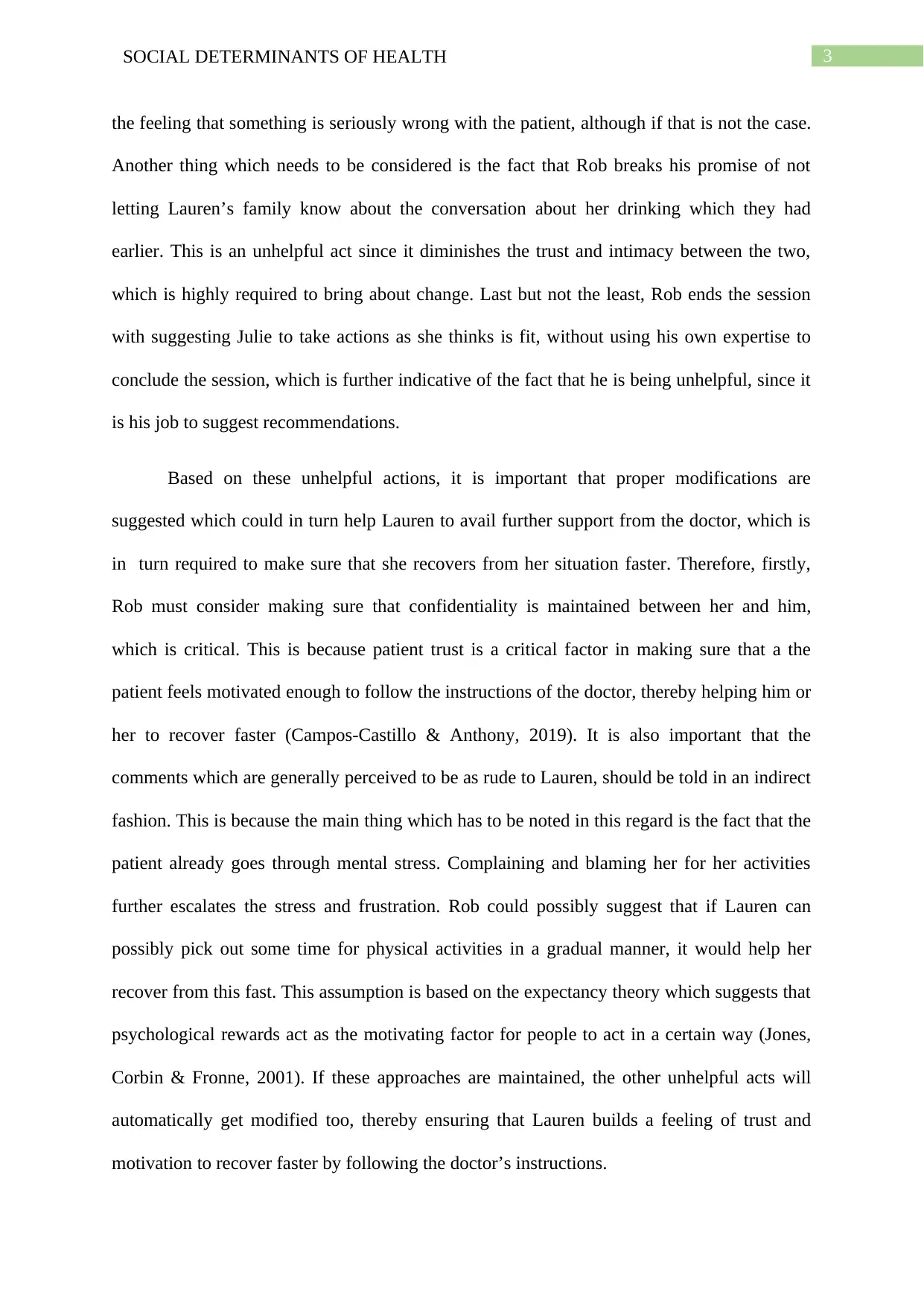
3SOCIAL DETERMINANTS OF HEALTH
the feeling that something is seriously wrong with the patient, although if that is not the case.
Another thing which needs to be considered is the fact that Rob breaks his promise of not
letting Lauren’s family know about the conversation about her drinking which they had
earlier. This is an unhelpful act since it diminishes the trust and intimacy between the two,
which is highly required to bring about change. Last but not the least, Rob ends the session
with suggesting Julie to take actions as she thinks is fit, without using his own expertise to
conclude the session, which is further indicative of the fact that he is being unhelpful, since it
is his job to suggest recommendations.
Based on these unhelpful actions, it is important that proper modifications are
suggested which could in turn help Lauren to avail further support from the doctor, which is
in turn required to make sure that she recovers from her situation faster. Therefore, firstly,
Rob must consider making sure that confidentiality is maintained between her and him,
which is critical. This is because patient trust is a critical factor in making sure that a the
patient feels motivated enough to follow the instructions of the doctor, thereby helping him or
her to recover faster (Campos-Castillo & Anthony, 2019). It is also important that the
comments which are generally perceived to be as rude to Lauren, should be told in an indirect
fashion. This is because the main thing which has to be noted in this regard is the fact that the
patient already goes through mental stress. Complaining and blaming her for her activities
further escalates the stress and frustration. Rob could possibly suggest that if Lauren can
possibly pick out some time for physical activities in a gradual manner, it would help her
recover from this fast. This assumption is based on the expectancy theory which suggests that
psychological rewards act as the motivating factor for people to act in a certain way (Jones,
Corbin & Fronne, 2001). If these approaches are maintained, the other unhelpful acts will
automatically get modified too, thereby ensuring that Lauren builds a feeling of trust and
motivation to recover faster by following the doctor’s instructions.
the feeling that something is seriously wrong with the patient, although if that is not the case.
Another thing which needs to be considered is the fact that Rob breaks his promise of not
letting Lauren’s family know about the conversation about her drinking which they had
earlier. This is an unhelpful act since it diminishes the trust and intimacy between the two,
which is highly required to bring about change. Last but not the least, Rob ends the session
with suggesting Julie to take actions as she thinks is fit, without using his own expertise to
conclude the session, which is further indicative of the fact that he is being unhelpful, since it
is his job to suggest recommendations.
Based on these unhelpful actions, it is important that proper modifications are
suggested which could in turn help Lauren to avail further support from the doctor, which is
in turn required to make sure that she recovers from her situation faster. Therefore, firstly,
Rob must consider making sure that confidentiality is maintained between her and him,
which is critical. This is because patient trust is a critical factor in making sure that a the
patient feels motivated enough to follow the instructions of the doctor, thereby helping him or
her to recover faster (Campos-Castillo & Anthony, 2019). It is also important that the
comments which are generally perceived to be as rude to Lauren, should be told in an indirect
fashion. This is because the main thing which has to be noted in this regard is the fact that the
patient already goes through mental stress. Complaining and blaming her for her activities
further escalates the stress and frustration. Rob could possibly suggest that if Lauren can
possibly pick out some time for physical activities in a gradual manner, it would help her
recover from this fast. This assumption is based on the expectancy theory which suggests that
psychological rewards act as the motivating factor for people to act in a certain way (Jones,
Corbin & Fronne, 2001). If these approaches are maintained, the other unhelpful acts will
automatically get modified too, thereby ensuring that Lauren builds a feeling of trust and
motivation to recover faster by following the doctor’s instructions.
Secure Best Marks with AI Grader
Need help grading? Try our AI Grader for instant feedback on your assignments.

4SOCIAL DETERMINANTS OF HEALTH
Last but not the least, the main theoretical framework which Rob should adopt to
assist Lauren in getting rid of the alcohol consumption habits, is the 5 A’s intervention
protocol. Rob should first consider addressing the main problem. He should first start by
clarifying the main risks associated with alcohol consumption, to establish the fear element.
The next step is to assess any barriers which could be existing in the way of Lauren that is
stopping Lauren from giving up on that behavior, which in this case, is the close attachment
which Lauren shares with her peers who have an influence on Lauren’s drinking habits. The
next step is to advise Lauren on how she can get rid of the habit. For example, Rob can be
specific and tell Lauren on how to avoid alcohol consumption or how to control the urge
when offered by her friends, while still remaining friends with them. This might help Lauren
get unattached from the peer group altogether. The next step of intervention is to assist
Lauren in making that happen. He can demonstrate himself on how exactly urge could be
controlled and help her practice the same. Finally, he must follow up on her regarding the
same, to ensure that the intervention has been effective.
Another theory, which could be applied by Rob, is Motivational Interviewing. Rob
should be empathetic towards Lauren, develop a discrepancy, roll along with the resistance
brought about by Lauren, and support her self efficacy. This model specializes in treating
alcohol addition, and therefore, would be an apt model for Rob to adopt. Rob must also have
the effective skills to apply the theory into practice effectively. These skills include being
affirmative, effective listening skills, summarizing skills, and also being able to ask trust
building open ended questions.
So as to conclude, it can be said that Lauren has been facing difficulties in her life
pertaining to her adolescent stage of development and alcohol consumption. Rob has been a
polite consultant to her, putting forward various helpful actions and suggestions for her, But
Lauren largely seems uninterested. Rob has also been unintentionally unhelpful, like
Last but not the least, the main theoretical framework which Rob should adopt to
assist Lauren in getting rid of the alcohol consumption habits, is the 5 A’s intervention
protocol. Rob should first consider addressing the main problem. He should first start by
clarifying the main risks associated with alcohol consumption, to establish the fear element.
The next step is to assess any barriers which could be existing in the way of Lauren that is
stopping Lauren from giving up on that behavior, which in this case, is the close attachment
which Lauren shares with her peers who have an influence on Lauren’s drinking habits. The
next step is to advise Lauren on how she can get rid of the habit. For example, Rob can be
specific and tell Lauren on how to avoid alcohol consumption or how to control the urge
when offered by her friends, while still remaining friends with them. This might help Lauren
get unattached from the peer group altogether. The next step of intervention is to assist
Lauren in making that happen. He can demonstrate himself on how exactly urge could be
controlled and help her practice the same. Finally, he must follow up on her regarding the
same, to ensure that the intervention has been effective.
Another theory, which could be applied by Rob, is Motivational Interviewing. Rob
should be empathetic towards Lauren, develop a discrepancy, roll along with the resistance
brought about by Lauren, and support her self efficacy. This model specializes in treating
alcohol addition, and therefore, would be an apt model for Rob to adopt. Rob must also have
the effective skills to apply the theory into practice effectively. These skills include being
affirmative, effective listening skills, summarizing skills, and also being able to ask trust
building open ended questions.
So as to conclude, it can be said that Lauren has been facing difficulties in her life
pertaining to her adolescent stage of development and alcohol consumption. Rob has been a
polite consultant to her, putting forward various helpful actions and suggestions for her, But
Lauren largely seems uninterested. Rob has also been unintentionally unhelpful, like
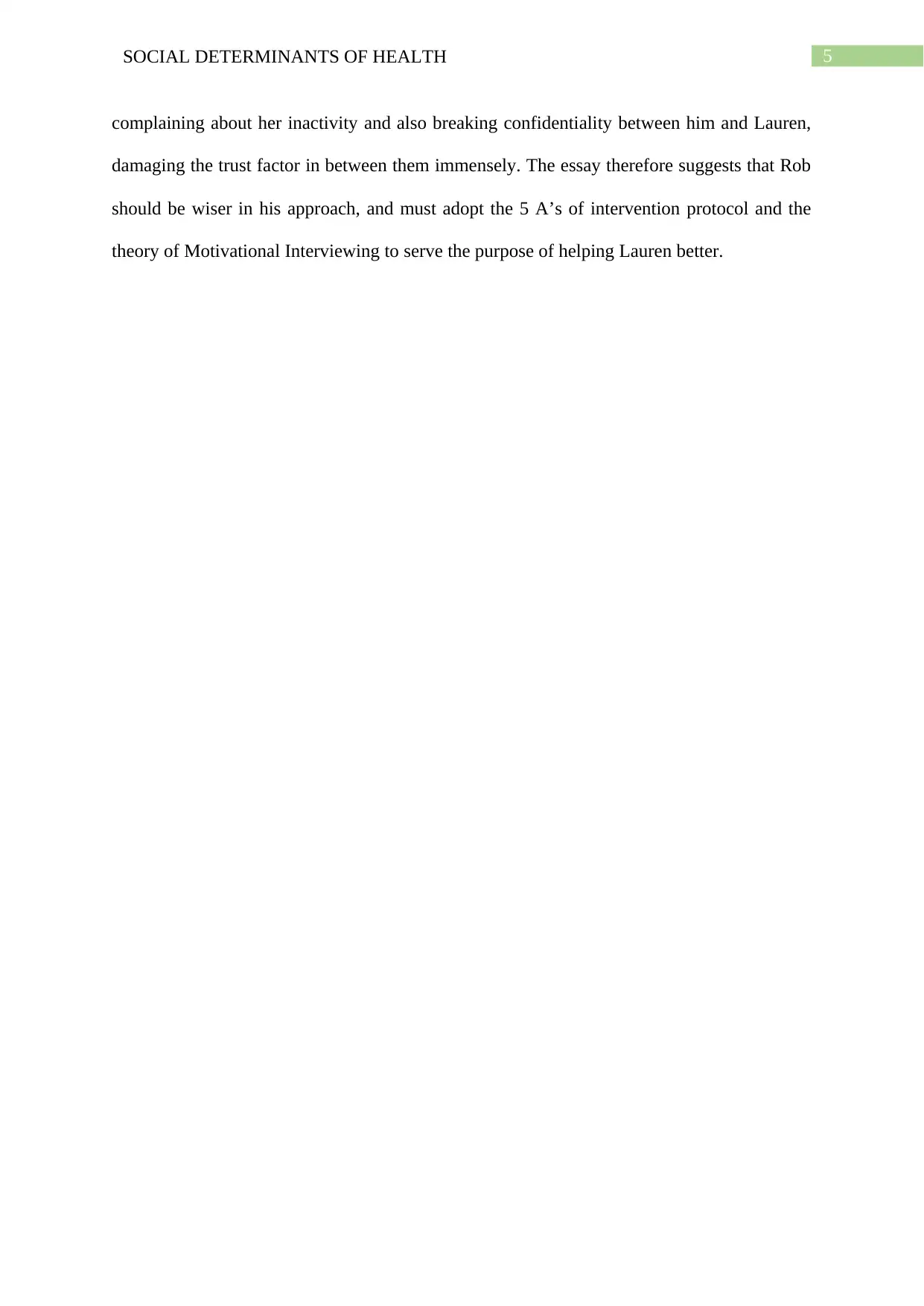
5SOCIAL DETERMINANTS OF HEALTH
complaining about her inactivity and also breaking confidentiality between him and Lauren,
damaging the trust factor in between them immensely. The essay therefore suggests that Rob
should be wiser in his approach, and must adopt the 5 A’s of intervention protocol and the
theory of Motivational Interviewing to serve the purpose of helping Lauren better.
complaining about her inactivity and also breaking confidentiality between him and Lauren,
damaging the trust factor in between them immensely. The essay therefore suggests that Rob
should be wiser in his approach, and must adopt the 5 A’s of intervention protocol and the
theory of Motivational Interviewing to serve the purpose of helping Lauren better.
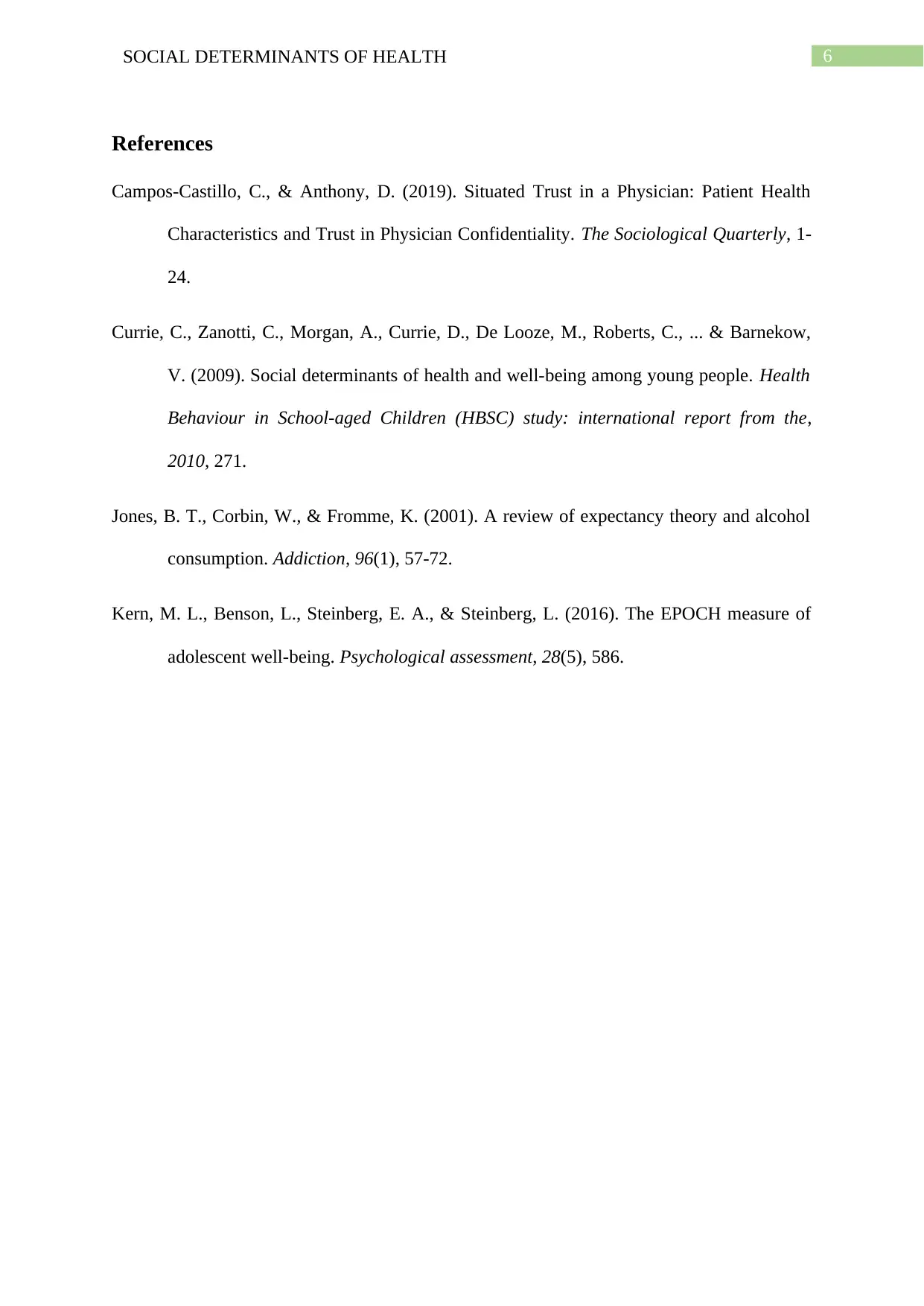
6SOCIAL DETERMINANTS OF HEALTH
References
Campos-Castillo, C., & Anthony, D. (2019). Situated Trust in a Physician: Patient Health
Characteristics and Trust in Physician Confidentiality. The Sociological Quarterly, 1-
24.
Currie, C., Zanotti, C., Morgan, A., Currie, D., De Looze, M., Roberts, C., ... & Barnekow,
V. (2009). Social determinants of health and well-being among young people. Health
Behaviour in School-aged Children (HBSC) study: international report from the,
2010, 271.
Jones, B. T., Corbin, W., & Fromme, K. (2001). A review of expectancy theory and alcohol
consumption. Addiction, 96(1), 57-72.
Kern, M. L., Benson, L., Steinberg, E. A., & Steinberg, L. (2016). The EPOCH measure of
adolescent well-being. Psychological assessment, 28(5), 586.
References
Campos-Castillo, C., & Anthony, D. (2019). Situated Trust in a Physician: Patient Health
Characteristics and Trust in Physician Confidentiality. The Sociological Quarterly, 1-
24.
Currie, C., Zanotti, C., Morgan, A., Currie, D., De Looze, M., Roberts, C., ... & Barnekow,
V. (2009). Social determinants of health and well-being among young people. Health
Behaviour in School-aged Children (HBSC) study: international report from the,
2010, 271.
Jones, B. T., Corbin, W., & Fromme, K. (2001). A review of expectancy theory and alcohol
consumption. Addiction, 96(1), 57-72.
Kern, M. L., Benson, L., Steinberg, E. A., & Steinberg, L. (2016). The EPOCH measure of
adolescent well-being. Psychological assessment, 28(5), 586.
1 out of 7
Related Documents
Your All-in-One AI-Powered Toolkit for Academic Success.
+13062052269
info@desklib.com
Available 24*7 on WhatsApp / Email
![[object Object]](/_next/static/media/star-bottom.7253800d.svg)
Unlock your academic potential
© 2024 | Zucol Services PVT LTD | All rights reserved.





